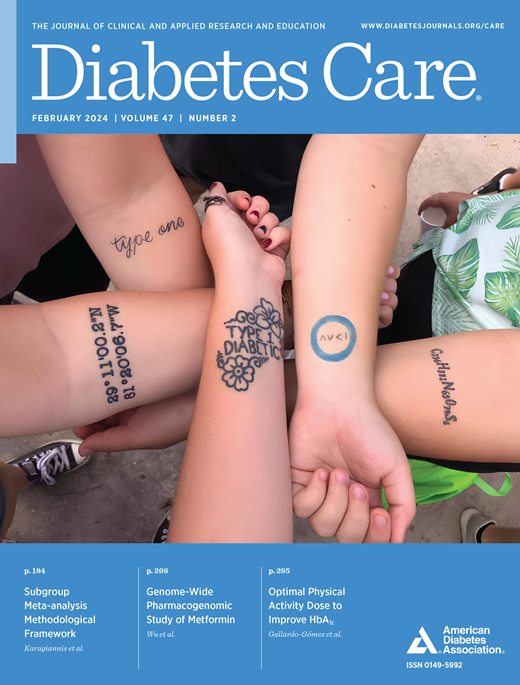急性复发性和慢性胰腺炎患儿的胰岛自身抗体及其与β细胞功能和糖尿病指标的关系
IF 16.6
1区 医学
Q1 ENDOCRINOLOGY & METABOLISM
引用次数: 0
摘要
目的 在急性复发性胰腺炎(ARP)和慢性胰腺炎(CP)患儿中,循环中的胰岛自身抗体(auto-Ab)可能会影响β细胞的功能。本研究报告了胰岛自身抗体在患有急性胰腺炎/慢性胰腺炎的青少年中的流行率,并调查了胰岛自身抗体对混合膳食耐受试验(MMTT)中胰岛素分泌指数和糖尿病状态的影响。研究设计与方法 这是一项回顾性横断面分析,研究对象是 234 名接受过胰岛抗体检测的 ARP/CP 患者。Ab+ 组 n = 28(12%),Ab- 组 n = 206(88%)。收集了空腹血糖和 HbA1c。78%的患者(234 例中的 183 例)进行了 MMTT 检测。计算 MMTT 衍生指数并进行组间比较。结果 Ab+ 组和 Ab- 组在年龄、性别、种族、民族、BMI 百分位数或空腹血糖方面没有差异。在 Ab+ 患者中,54% 有一个 Ab+,46% 有多个 Ab+。与 Ab- 组相比,Ab+ 组的 HbA1c 较高(中位数为 5.7 vs. 5.2%,P < 0.01),C 肽较低(中位数为 2.4 vs. 3.7 ng/mL,P = 0.01)。与 Ab- 组相比,Ab+ 组的糖尿病前期/糖尿病比例更高(57% 对 32%,P < 0.001)。在生存分析中,Ab+组从首次急性胰腺炎发作到发展为糖尿病的时间明显更短(P = 0.02)。结论 在急性胰腺炎/急性胰腺炎患儿中,Ab+与较高的糖尿病/糖尿病发展风险和较短的糖尿病发展时间相关,这表明胰岛Ab+与该患者队列中的β细胞功能障碍相关。胰岛抗体+还与较高的 HbA1c 和较低的 C 肽水平有关。未来的研究需要验证胰岛抗体阳性在胰腺炎中的作用。本文章由计算机程序翻译,如有差异,请以英文原文为准。
Islet Autoantibodies and Their Association With β-Cell Function and Diabetes Measures in Children With Acute Recurrent and Chronic Pancreatitis
OBJECTIVE In children with acute recurrent pancreatitis (ARP) and chronic pancreatitis (CP), circulating islet autoantibodies (auto-Ab) may influence β-cell function. This study reports Ab prevalence in youth with ARP/CP, and investigates effects on indices of insulin secretion during mixed meal tolerance testing (MMTT) and diabetes status. RESEARCH DESIGN AND METHODS This was a retrospective cross-sectional analysis of 234 youth with ARP/CP who had islet Ab testing. Ab+ group n = 28 (12%), and Ab− group n = 206 (88%). Fasting glucose and HbA1c were collected. MMTT was performed in 78% (183 of 234). MMTT-derived indices were calculated and compared between groups. RESULTS The Ab+ and Ab− groups did not differ in age, sex, race, ethnicity, BMI percentile, or fasting glucose. Of Ab+ patients, 54% had one Ab+ and 46% had multiple Ab+. Comparing the Ab+ to Ab− groups, HbA1c was higher (median 5.7 vs. 5.2%, P < 0.01), and C-peptide was lower (median 2.4 vs. 3.7 ng/mL, P = 0.01) in the Ab+ group. The Ab+ compared with the Ab− group had a higher proportion of prediabetes/diabetes (57% vs. 32%, P < 0.001). In survival analysis, the Ab+ group had significantly shorter time from first acute pancreatitis episode to diabetes development (P = 0.02). CONCLUSIONS In children with ARP/CP, Ab+ was associated with higher risk of diabetes/diabetes development, and shorter time to diabetes development, suggesting that islet Ab+ is associated with β-cell dysfunction in this patient cohort. Islet Ab+ was also associated with higher HbA1c and lower C-peptide levels. Future studies are needed to validate the role of islet Ab positivity in pancreatitis.
求助全文
通过发布文献求助,成功后即可免费获取论文全文。
去求助
来源期刊

Diabetes Care
医学-内分泌学与代谢
CiteScore
27.80
自引率
4.90%
发文量
449
审稿时长
1 months
期刊介绍:
The journal's overarching mission can be captured by the simple word "Care," reflecting its commitment to enhancing patient well-being. Diabetes Care aims to support better patient care by addressing the comprehensive needs of healthcare professionals dedicated to managing diabetes.
Diabetes Care serves as a valuable resource for healthcare practitioners, aiming to advance knowledge, foster research, and improve diabetes management. The journal publishes original research across various categories, including Clinical Care, Education, Nutrition, Psychosocial Research, Epidemiology, Health Services Research, Emerging Treatments and Technologies, Pathophysiology, Complications, and Cardiovascular and Metabolic Risk. Additionally, Diabetes Care features ADA statements, consensus reports, review articles, letters to the editor, and health/medical news, appealing to a diverse audience of physicians, researchers, psychologists, educators, and other healthcare professionals.
 求助内容:
求助内容: 应助结果提醒方式:
应助结果提醒方式:


